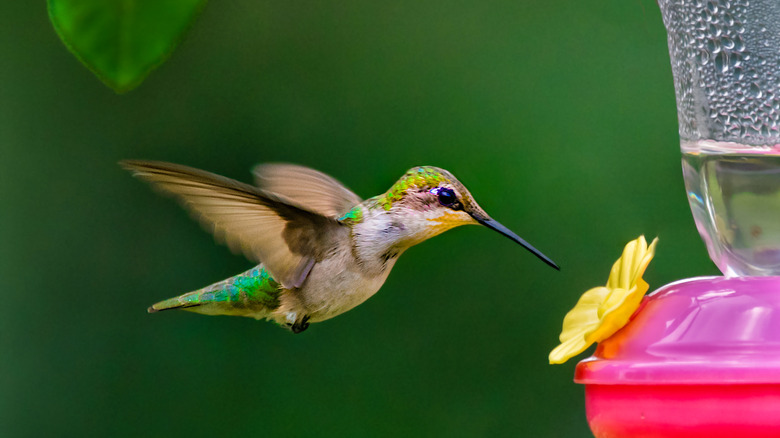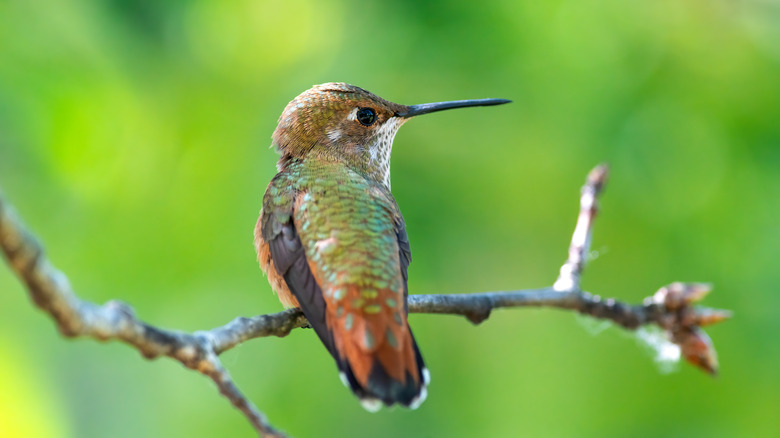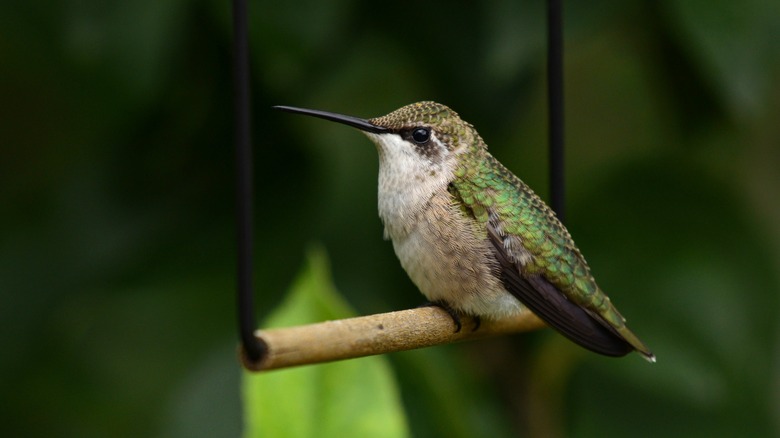Why You Should Stick A Dead Branch Into The Ground Near Your Hummingbird Feeder
Hummingbirds are the Chihuahuas of the bird world. It seems like their tiny bodies can barely contain their big personalities. Their feisty behavior and aerial antics make these jewel-toned beauties fun to watch, so it's no surprise that hummingbird feeders are a popular addition to many yards. While feeders and flowers are an effective way to attract hummingbirds to your garden or patio, there is one more thing you can add to your hummer habitat if you want these avian acrobats to stick around.
Even though they always seem to be in motion, hummingbirds appreciate a place to rest. After flapping their wings at a rate of nearly 80 times per second, you can't blame them for needing a break. A dead tree branch — sometimes called a snag — provides a spot where they can survey their surroundings and keep their eyes on your feeder. By placing a snag in your yard, hummingbirds are more likely to stick close by since they don't have to fly farther away to find a good vantage point.
How dead branches benefit hummingbirds
A snag is technically an upright dead or dying tree that is used by various wildlife for nesting and roosting. Their bare limbs provide ideal perches for many bird species, including hummingbirds. Resting on the ground is dangerous for hummingbirds because they have tiny feet and can't walk or hop. But they do use their feet to perch.
Snags are used by both males and females to get a bird's-eye view of their territories (in this case, your feeder) so they can chase off interlopers. Snags also provide a visible spot for courtship displays and an open environment for singing. With less foliage to dampen sounds, male hummers can project their songs over greater distances (via Richardson Bay Audubon Center).
Hummingbirds also use snags to hunt insects. While sugary snacks like nectar provide fuel to maintain their high metabolism and keep their hearts beating up to 1,300 times per minute, they can't subsist on a liquid diet alone. Hummingbirds need protein for muscle and feather development, which they get by consuming insects. A single hummingbird eats hundreds or even thousands of insects per day. This is great news for your garden. Ants, aphids, fruit flies, gnats, weevils, beetles, mites, mosquitoes, and even certain wasps are all on the menu. If you want a closer look at their bug-catching abilities, an overripe banana will attract more hummingbirds and insects to your yard. Just place it near your feeder or flowering plants to lure fruit flies and other small bugs.
How to place a branch or other perch near your hummingbird feeder
If you don't have space for a dead tree in your yard (or a decaying plant aesthetic is not really your thing), you can create a smaller version of a snag by sticking a dead tree branch in the ground so that it stands upright about 20 to 50 feet from your feeder. Ideally, the branch should be tall enough for hummers to look down on the feeder. You'll also want to choose a branch that has twigs small enough to accommodate the birds' petite feet. If you don't want to stick the branch directly into the ground, you can anchor it in a large pot filled with enough rocks, soil, or concrete to keep it stable.
Of course, a dead branch might be impractical in many situations, particularly if you have a small patio or balcony. One idea is to strap small branches onto your balcony railing. Another alternative is to create a simple DIY swing using wire and wooden dowels or sticks. If you're not feeling particularly crafty, you can purchase pre-made swings from many pet supply shops or home improvement stores, like this one from Lowes. Clothesline made from natural fibers like cotton can be used in a pinch. Just string it taut a few feet above the feeder. Even these simple perches will make your hummers happy and more likely to stick around.


